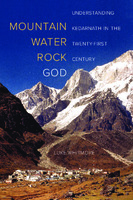Mountain, Water, Rock, God
Understanding Kedarnath in the Twenty-First Century
| dc.contributor.author | Whitmore, Luke | |
| dc.date.accessioned | 2018-12-12 14:12:57 | |
| dc.date.accessioned | 2020-04-01T11:54:57Z | |
| dc.date.available | 2020-04-01T11:54:57Z | |
| dc.date.issued | 2019 | |
| dc.identifier | 1002524 | |
| dc.identifier | OCN: 1083010324 | en_US |
| dc.identifier.uri | http://library.oapen.org/handle/20.500.12657/27485 | |
| dc.description.abstract | In Mountain, Water, Rock, God, Luke Whitmore situates the disastrous flooding that fell on the Hindu Himalayan shrine of Kedarnath in 2013 within its broader religious and ecological contexts. For centuries, the enmeshing of Shiva with the Himalayan environment has animated how Hindus conceptualize and experience Kedarnath. The floods publicly affirmed the fundamentally Himalayan and Shiva-oriented character of this place. At the same time, the floods made it clear that the patterns of commercialization, development, and regulation of recent decades in Uttarakhand, patterns that arose in response to new statehood and an influx of middle-class pilgrims and tourists, were starkly out of place. People connected to Kedarnath today therefore understand both the floods and the recent short-sighted development that multiplied the impact of the floods both as the natural consequence of human fault and as an indication of a growing disconnect with the Himalayan environment and its resident divine powers. Whitmore explores the longer story of this powerful realm of Shiva through a holistic theoretical perspective that integrates phenomenological and systems-based approaches to the study of religion, pilgrimage, place, and ecology by thinking about Kedarnath as a place that is experienced as an ecosocial system characterized by complexity. He argues that close attention to places of religious significance offers a portable theoretical model for thinking through connections between ritual, narrative, climate change, tourism, religion, development, and disaster, and shows how these critical components of human life in the twenty-first century intersect in the human experience of place. | |
| dc.language | English | |
| dc.subject.classification | thema EDItEUR::N History and Archaeology::NH History::NHF Asian history | en_US |
| dc.subject.classification | thema EDItEUR::Q Philosophy and Religion::QR Religion and beliefs::QRA Religion: general | en_US |
| dc.subject.classification | thema EDItEUR::R Earth Sciences, Geography, Environment, Planning::RN The environment | en_US |
| dc.subject.other | place | |
| dc.subject.other | Kedarnath | |
| dc.subject.other | Shiva | |
| dc.subject.other | ecology | |
| dc.subject.other | development | |
| dc.subject.other | disaster | |
| dc.subject.other | complexity | |
| dc.subject.other | pilgrimage | |
| dc.subject.other | tourism | |
| dc.subject.other | Hindu | |
| dc.subject.other | phenomenology | |
| dc.subject.other | Himalaya | |
| dc.title | Mountain, Water, Rock, God | |
| dc.title.alternative | Understanding Kedarnath in the Twenty-First Century | |
| dc.type | book | |
| oapen.identifier.doi | 10.1525/luminos.61 | |
| oapen.relation.isPublishedBy | 72f3a53e-04bb-4d73-b921-22a29d903b3b | |
| oapen.relation.isbn | 9780520298026 | |
| oapen.pages | 280 | |
| oapen.place.publication | Oakland | |
| oapen.identifier.ocn | 1083010324 |

